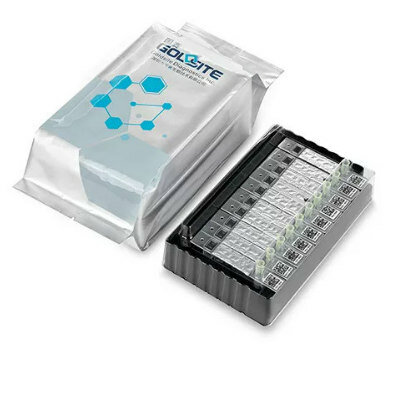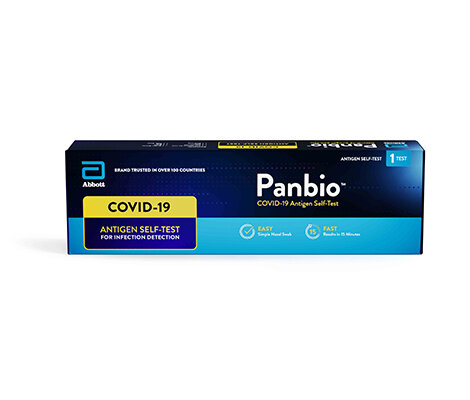Natural Killer Cell-Associated Markers Investigated in Gastric Cancer
|
By LabMedica International staff writers Posted on 11 Jan 2022 |

Image: Advanced stage of stomach cancer with stomach tissue array, including pathology grade, malignant tumors (TNM) and clinical stage (Photo courtesy of SuperBioChips Laboratories)
Gastric cancer (GC) is one of the leading causes of cancer-related deaths worldwide. Although the survival rates of GC patients have increased with proper screening systems, standardized surgical protocols, and development of chemotherapy regimens, the general outcome of GC patients, especially those in advanced stages, remains poor.
The importance of the tumor immune microenvironment (TME) has been well-established in the last two decades. Various immune cell populations and stromal cells in the TME and tumor cells play an important role by interacting with each other, leading to tumor suppression or progression. Characterizing the interactions between immune cells and tumor cells is critical to understand the TME.
Clinical Scientists at the Seoul National University College of Medicine (Seoul, Republic of Korea) recruited for a study a total of 55 cases of consecutive stage II-III GC surgically resected between 2006 and 2008. The formalin-fixed, paraffin-embedded (FFPE) tissue samples were reviewed, and representative tissue areas were dissected for the construct a tissue microarray (TMA). The team performed multiplex immunohistochemistry (mIHC) on the tissue microarrays slides. A total of 11 antibodies including CD57, NKG2A, CD16, HLA-E, CD3, CD20, CD45, CD68, CK, SMA, and ki-67 were used. CD45 + CD3-CD57 + cells were considered as CD57 + NK cells.
For molecular classification of the GC samples, conventional immunohistochemistry (IHC) for E-cadherin and p53 was performed on 3-μm-thick TMA slides using an automated BenchMark XT immunostainer (Ventana Medical Systems, Tucson, AZ USA). All implementations and analysis of mIHC were performed on the SuperBioChips (SuperBioChips Laboratories, Seoul, Korea). Polymerase chain reaction (PCR) amplification of the extracted DNA from tumor and normal cells was performed and the PCR products were analyzed using a DNA autosequencer, the ABI 3731 Genetic Analyzer (Applied Biosystems, Foster City, CA, USA).
The investigators reported that among CD45 + immune cells, the proportion of CD57 + NK cell was the lowest (3.8%), whereas that of CD57 + and CD57- T cells (65.5%) was the highest, followed by macrophages (25.4%), and B cells (5.3%). CD57 + NK cells constituted 20% of CD45 + CD57 + immune cells while the remaining 80% were CD57 + T cells. The expression of HLA-E in tumor cells correlated with that in tumoral T cells, B cells, and macrophages, but not CD57 + NK cells. The higher density of tumoral CD57 + NK cells and tumoral CD57 + NKG2A + NK cells was associated with inferior survival.
The authors concluded that although the number of CD57 + NK cells was lower than that of other immune cells, CD57 + NK cells and CD57 + NKG2A + NK cells were significantly associated with poor outcomes, suggesting that NK cell subsets play a critical role in GC progression. NK cells and their inhibitory receptor, NKG2A, may be potential targets in GC. The study was published on December 24, 2021 in the Journal of Translational Medicine.
Related Links:
Seoul National University College of Medicine
Ventana Medical Systems
SuperBioChips Laboratories
Applied Biosystems
The importance of the tumor immune microenvironment (TME) has been well-established in the last two decades. Various immune cell populations and stromal cells in the TME and tumor cells play an important role by interacting with each other, leading to tumor suppression or progression. Characterizing the interactions between immune cells and tumor cells is critical to understand the TME.
Clinical Scientists at the Seoul National University College of Medicine (Seoul, Republic of Korea) recruited for a study a total of 55 cases of consecutive stage II-III GC surgically resected between 2006 and 2008. The formalin-fixed, paraffin-embedded (FFPE) tissue samples were reviewed, and representative tissue areas were dissected for the construct a tissue microarray (TMA). The team performed multiplex immunohistochemistry (mIHC) on the tissue microarrays slides. A total of 11 antibodies including CD57, NKG2A, CD16, HLA-E, CD3, CD20, CD45, CD68, CK, SMA, and ki-67 were used. CD45 + CD3-CD57 + cells were considered as CD57 + NK cells.
For molecular classification of the GC samples, conventional immunohistochemistry (IHC) for E-cadherin and p53 was performed on 3-μm-thick TMA slides using an automated BenchMark XT immunostainer (Ventana Medical Systems, Tucson, AZ USA). All implementations and analysis of mIHC were performed on the SuperBioChips (SuperBioChips Laboratories, Seoul, Korea). Polymerase chain reaction (PCR) amplification of the extracted DNA from tumor and normal cells was performed and the PCR products were analyzed using a DNA autosequencer, the ABI 3731 Genetic Analyzer (Applied Biosystems, Foster City, CA, USA).
The investigators reported that among CD45 + immune cells, the proportion of CD57 + NK cell was the lowest (3.8%), whereas that of CD57 + and CD57- T cells (65.5%) was the highest, followed by macrophages (25.4%), and B cells (5.3%). CD57 + NK cells constituted 20% of CD45 + CD57 + immune cells while the remaining 80% were CD57 + T cells. The expression of HLA-E in tumor cells correlated with that in tumoral T cells, B cells, and macrophages, but not CD57 + NK cells. The higher density of tumoral CD57 + NK cells and tumoral CD57 + NKG2A + NK cells was associated with inferior survival.
The authors concluded that although the number of CD57 + NK cells was lower than that of other immune cells, CD57 + NK cells and CD57 + NKG2A + NK cells were significantly associated with poor outcomes, suggesting that NK cell subsets play a critical role in GC progression. NK cells and their inhibitory receptor, NKG2A, may be potential targets in GC. The study was published on December 24, 2021 in the Journal of Translational Medicine.
Related Links:
Seoul National University College of Medicine
Ventana Medical Systems
SuperBioChips Laboratories
Applied Biosystems
Latest Pathology News
- Spatial Tissue Analysis Identifies Patterns Associated With Ovarian Cancer Relapse
- Unique Hand-Warming Technology Supports High-Quality Fingertip Blood Sample Collection
- Image-Based AI Shows Promise for Parasite Detection in Digitized Stool Samples
- Deep Learning Powered AI Algorithms Improve Skin Cancer Diagnostic Accuracy
- Microfluidic Device for Cancer Detection Precisely Separates Tumor Entities
- Virtual Skin Biopsy Determines Presence of Cancerous Cells
- AI Detects Viable Tumor Cells for Accurate Bone Cancer Prognoses Post Chemotherapy
- First Ever Technique Identifies Single Cancer Cells in Blood for Targeted Treatments
- Innovative Blood Collection Device Overcomes Common Obstacles Related to Phlebotomy
- Intra-Operative POC Device Distinguishes Between Benign and Malignant Ovarian Cysts within 15 Minutes
- Simple Skin Biopsy Test Detects Parkinson’s and Related Neurodegenerative Diseases
- Bioinformatics Tool to Identify Chromosomal Alterations in Tumor Cells Can Improve Cancer Diagnosis
- Coin-Sized Device Rapidly Isolates Blood Plasma for Quicker and More Precise Clinical Diagnoses
- AI Predicts Cancer Spreading To Brain from Lung Biopsy Images
- Improved Microneedle Technology Speeds Up Extraction of Sample Interstitial Fluid for Disease Diagnosis
- AI Outperforms Expert Pathologists in Predicting Lung Cancer Spread
Channels
Clinical Chemistry
view channel
3D Printed Point-Of-Care Mass Spectrometer Outperforms State-Of-The-Art Models
Mass spectrometry is a precise technique for identifying the chemical components of a sample and has significant potential for monitoring chronic illness health states, such as measuring hormone levels... Read more.jpg)
POC Biomedical Test Spins Water Droplet Using Sound Waves for Cancer Detection
Exosomes, tiny cellular bioparticles carrying a specific set of proteins, lipids, and genetic materials, play a crucial role in cell communication and hold promise for non-invasive diagnostics.... Read more
Highly Reliable Cell-Based Assay Enables Accurate Diagnosis of Endocrine Diseases
The conventional methods for measuring free cortisol, the body's stress hormone, from blood or saliva are quite demanding and require sample processing. The most common method, therefore, involves collecting... Read moreMolecular Diagnostics
view channel
Unique Autoantibody Signature to Help Diagnose Multiple Sclerosis Years before Symptom Onset
Autoimmune diseases such as multiple sclerosis (MS) are thought to occur partly due to unusual immune responses to common infections. Early MS symptoms, including dizziness, spasms, and fatigue, often... Read more
Blood Test Could Detect HPV-Associated Cancers 10 Years before Clinical Diagnosis
Human papilloma virus (HPV) is known to cause various cancers, including those of the genitals, anus, mouth, throat, and cervix. HPV-associated oropharyngeal cancer (HPV+OPSCC) is the most common HPV-associated... Read moreHematology
view channel
Next Generation Instrument Screens for Hemoglobin Disorders in Newborns
Hemoglobinopathies, the most widespread inherited conditions globally, affect about 7% of the population as carriers, with 2.7% of newborns being born with these conditions. The spectrum of clinical manifestations... Read more
First 4-in-1 Nucleic Acid Test for Arbovirus Screening to Reduce Risk of Transfusion-Transmitted Infections
Arboviruses represent an emerging global health threat, exacerbated by climate change and increased international travel that is facilitating their spread across new regions. Chikungunya, dengue, West... Read more
POC Finger-Prick Blood Test Determines Risk of Neutropenic Sepsis in Patients Undergoing Chemotherapy
Neutropenia, a decrease in neutrophils (a type of white blood cell crucial for fighting infections), is a frequent side effect of certain cancer treatments. This condition elevates the risk of infections,... Read more
First Affordable and Rapid Test for Beta Thalassemia Demonstrates 99% Diagnostic Accuracy
Hemoglobin disorders rank as some of the most prevalent monogenic diseases globally. Among various hemoglobin disorders, beta thalassemia, a hereditary blood disorder, affects about 1.5% of the world's... Read moreMicrobiology
view channel
Mouth Bacteria Test Could Predict Colon Cancer Progression
Colon cancer, a relatively common but challenging disease to diagnose, requires confirmation through a colonoscopy or surgery. Recently, there has been a worrying increase in colon cancer rates among younger... Read more.jpg)
Unique Metabolic Signature Could Enable Sepsis Diagnosis within One Hour of Blood Collection
Sepsis is a life-threatening condition triggered by an extreme response of the body to an infection. It requires immediate medical intervention to prevent potential death or lasting damage.... Read morePathology
view channel
Spatial Tissue Analysis Identifies Patterns Associated With Ovarian Cancer Relapse
High-grade serous ovarian carcinoma is the most lethal type of ovarian cancer, and it poses significant detection challenges. Typically, patients initially respond to surgery and chemotherapy, but the... Read more.jpg)
Unique Hand-Warming Technology Supports High-Quality Fingertip Blood Sample Collection
Warming the hand is an effective way to facilitate blood collection from a fingertip, yet off-the-shelf solutions often do not fulfill laboratory requirements. Now, a unique hand-warming technology has... Read moreTechnology
view channel
New Diagnostic System Achieves PCR Testing Accuracy
While PCR tests are the gold standard of accuracy for virology testing, they come with limitations such as complexity, the need for skilled lab operators, and longer result times. They also require complex... Read more
DNA Biosensor Enables Early Diagnosis of Cervical Cancer
Molybdenum disulfide (MoS2), recognized for its potential to form two-dimensional nanosheets like graphene, is a material that's increasingly catching the eye of the scientific community.... Read more
Self-Heating Microfluidic Devices Can Detect Diseases in Tiny Blood or Fluid Samples
Microfluidics, which are miniature devices that control the flow of liquids and facilitate chemical reactions, play a key role in disease detection from small samples of blood or other fluids.... Read more
Breakthrough in Diagnostic Technology Could Make On-The-Spot Testing Widely Accessible
Home testing gained significant importance during the COVID-19 pandemic, yet the availability of rapid tests is limited, and most of them can only drive one liquid across the strip, leading to continued... Read moreIndustry
view channel
ECCMID Congress Name Changes to ESCMID Global
Over the last few years, the European Society of Clinical Microbiology and Infectious Diseases (ESCMID, Basel, Switzerland) has evolved remarkably. The society is now stronger and broader than ever before... Read more
Bosch and Randox Partner to Make Strategic Investment in Vivalytic Analysis Platform
Given the presence of so many diseases, determining whether a patient is presenting the symptoms of a simple cold, the flu, or something as severe as life-threatening meningitis is usually only possible... Read more
Siemens to Close Fast Track Diagnostics Business
Siemens Healthineers (Erlangen, Germany) has announced its intention to close its Fast Track Diagnostics unit, a small collection of polymerase chain reaction (PCR) testing products that is part of the... Read more
















